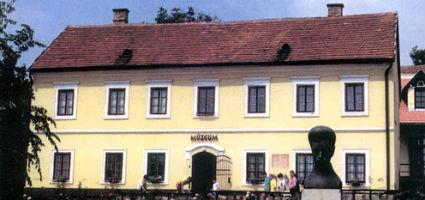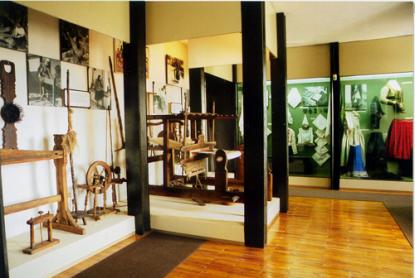2024. May 3. Friday
Petőfi Museum Pieces Compilation and Exhibition Ward - Aszód
 |
Address: 2170, Aszód Szontágh lépcső 2.
Phone number: (28) 780-176
E-mail: odler.zsolt@avkk.hu
Opening hours: 15.03-30.09.: Tue-Sun 10-18
14.03-01.10.: Mon-Fri 8-16, Sat-Sun 10-16 |
Museum tickets, service costs:
|
Ticket for adults
|
600 HUF
|
|
|
Ticket for students
|
300 HUF
|
|
|
Ticket for pensioners
|
300 HUF
|
|
|
Guide
|
3000 HUF
|
|
|
Photography
|
1000 HUF
|
The first room of the exhibition is the so called introduction room. Here you can see. "The Object of the Month" and the freshest new acquisitions, assemblages.

In the second room the Neolithic history of Aszód is on show. The Neolithic "metropolis" that was situated on the hill above the museum, was formed in the crossing point of two important roads. It was populated by the people of the so called Lengyel Culture. The excavations of this settlement and cemetery of Europe fame took place from the 1960-ies. The digs cannot be continued because of financial difficulties. There can be seen household objects, decorations, burial customs and a unique pot -a ceramic bird with human legs, which symbolised the life on earth and in the underworld, giving us a sense of the thinking system of the people who lived here 6 thousand years ago.
The third room shows the history of the Galga valley from the Bronze Age up to the end of Medieval times. Among a number of interesting objects to see, Bronze Age urns, an Iron Age diadem of a chief or a king and Avarian golden finds from Dány are to be mentioned.
The fourth room traces the development of the agriculture from the beginning of the 18th century until the first half of the 20th century. We show in details how the Galga valley was resettled. Through the objects of agriculture, animal husbandry and winegrowing culture you can get a picture about the farming of the past. A special window shows the local events of the Revolution and Liberation War of 1848-49.
The first room on the second floor presents the industrial development of the Galga Valley. In a reconstructed interior you see workshops of an Aszód blacksmith and a shoemaker. Valuable bellows from 1753 decorated with a dragon head, perspective view of Aszód from the 18th cent on a charter of incorporation of the bootmakers and the seal of the market town are also on show.
In the second and third room of the second floor you can observe the colourful folk costumes of the region. Costume was an important sign of different positions in the peasant society. P.specially the female costume expressed in a very sophisticated way the age of its owner, the marital, social and financial status This costumes differed in different villages by form, colours, motifs, but the principle of expression was the same. The costume culture of the Galga valley is widely famous. It formed under the influence of the ethnic group of Palotzes, but there was also an impact from Slovakian and German traditions as well. Beside richly decorated kerchiefs, head dresses, skirts a hope chest from 1792 is notable.
The fourth room preserves the relics of Aszódian school years of Petőfi, the local connections of his relatives families Petrovics and Hruz and the history of the Petőfi High School A very valuable object is the register of students, the Matricula of the school, in which we can read the study results of Alexander Petrovics (Sándor Petőfi) written by István Koren.

In the second room the Neolithic history of Aszód is on show. The Neolithic "metropolis" that was situated on the hill above the museum, was formed in the crossing point of two important roads. It was populated by the people of the so called Lengyel Culture. The excavations of this settlement and cemetery of Europe fame took place from the 1960-ies. The digs cannot be continued because of financial difficulties. There can be seen household objects, decorations, burial customs and a unique pot -a ceramic bird with human legs, which symbolised the life on earth and in the underworld, giving us a sense of the thinking system of the people who lived here 6 thousand years ago.
The third room shows the history of the Galga valley from the Bronze Age up to the end of Medieval times. Among a number of interesting objects to see, Bronze Age urns, an Iron Age diadem of a chief or a king and Avarian golden finds from Dány are to be mentioned.
The fourth room traces the development of the agriculture from the beginning of the 18th century until the first half of the 20th century. We show in details how the Galga valley was resettled. Through the objects of agriculture, animal husbandry and winegrowing culture you can get a picture about the farming of the past. A special window shows the local events of the Revolution and Liberation War of 1848-49.
The first room on the second floor presents the industrial development of the Galga Valley. In a reconstructed interior you see workshops of an Aszód blacksmith and a shoemaker. Valuable bellows from 1753 decorated with a dragon head, perspective view of Aszód from the 18th cent on a charter of incorporation of the bootmakers and the seal of the market town are also on show.
In the second and third room of the second floor you can observe the colourful folk costumes of the region. Costume was an important sign of different positions in the peasant society. P.specially the female costume expressed in a very sophisticated way the age of its owner, the marital, social and financial status This costumes differed in different villages by form, colours, motifs, but the principle of expression was the same. The costume culture of the Galga valley is widely famous. It formed under the influence of the ethnic group of Palotzes, but there was also an impact from Slovakian and German traditions as well. Beside richly decorated kerchiefs, head dresses, skirts a hope chest from 1792 is notable.
The fourth room preserves the relics of Aszódian school years of Petőfi, the local connections of his relatives families Petrovics and Hruz and the history of the Petőfi High School A very valuable object is the register of students, the Matricula of the school, in which we can read the study results of Alexander Petrovics (Sándor Petőfi) written by István Koren.
